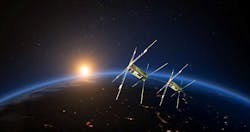SRI International beacons launched for NASA research on signal disruption
MENLO PARK, Calif., - SRI International announced the launch of the Enhanced Tandem Beacon Experiment (E-TBEx) on June 25, 2019, as part of a mission supported by NASA to gather atmospheric data and study how space weather impacts our communication and navigation systems.
Leveraging decades of radio beacon expertise developed by SRI International, the mission aims to study natural bubbles that form in the electrically-charged layers of Earth's upper atmosphere that can compromise communication and navigation signals as they pass from space to the ground. Because these bubbles appear and evolve unpredictably, they are difficult for scientists to study from the ground and predict how they change and disrupt radio signal performance.
E-TBEx uses two CubeSat satellites complemented with six larger spacecraft COSMIC-2 satellites to send test signals, similar to those used by communications and GPS satellites, at various frequencies. SRI researchers will observe how the signals are received on the ground, and then measure where and how the signals are distorted by these atmospheric bubbles as they evolve in real-time. The combination of measurements from all eight satellites will give scientists an unprecedented opportunity to study these bubbles from multiple angles at the same time.
The experiment will be completed after one year in orbit, and researchers plan to apply the findings to improve forecasting models and strategies to mitigate the harmful impacts to commercial navigation systems and tactical military communication.
SRI International has five decades of science and engineering expertise in space-based radio beacon design, assembly, test and operations dating back to the early NASA Pioneer research spacecraft. The CubeSat spacecraft hosting the beacons is supported by NASA and was co-designed by students and faculty at the University of Michigan Exploration Laboratory. The E-TBEx and COSMIC-2 missions were launched from NASA Kennedy Space Center aboard the U.S. Air Force Space Test Program-2 (STP-2) Falcon Heavy vehicle.
